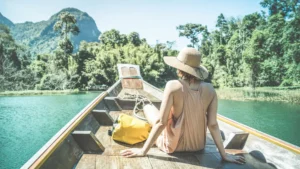My excitement upon visiting Puerto Princesa came from curiosity at first. I’m from Davao City, which has a lot in common with Puerto Princesa. Apart from both claiming to be the largest city in the country (Davao has a land area of 244,000 hectares, and Puerto Princesa has 253,982 hectares), both are also consistent and proud recipients of Presidential Awards like the Cleanest and Greenest Highly-Urbanized City in the Philippines.
But once I arrived at the airport, my mind became more open to exploration. Puerto Princesa is teeming with lush forests, amazing species of flora and fauna (I have read that Palawan was once connected to mainland Borneo millions of years ago, thus having closer similarities with the wildlife of Borneo). Imagine living in a quiet provincial city with a tropical paradise within its borders.
While a guided city tour was enjoyable, the highlight was still a day’s trek to the world renowned Puerto Princesa Subterranean River National Park. The navigable part of its river inside the 4,000-acre cave stretches 8.2 kilometers in length (five miles) before it drains out into the South China Sea. The park is over 20,000 hectares in size with a core zone of over 5,000 hectares (almost as big as Makati City). While Palawan has claimed this treasure to be the world’s longest underground river, the title was surpassed by Vietnam’s Son Trach underground river reaching seven miles in length. The latest discovery in 2007, however, gave way to Mexico’s Yucatan Peninsula with an underground river estimated to be 95 miles long. The Puerto Princesa Subterranean River National Park is included in the UNESCO World Heritage List for being the only national park in the country with a thick tropical forest cover within the city. Its unique merits have also earned itself a nomination in the New Seven Wonders of Nature campaign.
We took a two-hour private van ride to Sabang town, passing through the beautiful limestone and marble cliffs of Cabayugan. In Sabang, we rode small motorized boats for 20 minutes to the St. Paul National Park, giving us glimpses of scenic mountain ranges, while coastingthrough emerald waters. After a short walk through the wildlife park and thick canopy of trees, we reached a quiet lagoon and put on helmets and life vests to start a twohour underground voyage with a funny and entertaining boatman named Oteng.
Darkness closed in on us once inside the spacious, chilly cave. Natural ventilation provided cool air even as we went deeper into an abyss decorated with stalactites, stalagmites, and cathedral-like chambers. Oteng began naming these uncanny natural rock formations as we passed by: a Holy Family tableau, St. Peter with a dog (not a rooster), large hanging vegetables, a sexy woman, two cats, and genital patterns that made us laugh.
This was not a good place for claustrophobics,by the way. Its eerie blackness and alternating narrow and wide passages will consume you after 30 minutes, which is still halfway throughthe cave. The only light that shone came from the helmet of the boat’s first passenger. Whenever an interesting area was being pointed at, we waited until light would swing in that direction. I asked Oteng to hold the boat steadily so I could shoot various pillars in one spot, and he jokingly offered to drop me off and just come back for me later.
While we were a noisy bunch of Filipinos, we passed by boats with foreign passengers who were hushed and stiff as cardboard cutouts, apparently nervous of the pitch black journey. We laughed our jitters off and made jokes all the way back to the mouth of the cave, relieved when almost blinded by sunlight. The long but thrilling spree in those deep chambers was certainly worth the experience, more so when your senses become acute in the darkness. Your imagination runs wild at sudden noises around you. It doesn’t help when your boatman nonchalantly tells you, “Oh, that’s just a crocodile.” For the record, lest you shudder, there are none inside that river.
La Venta
La Venta Geographical Association (http://www.laventa.it) is a team of explorers and researchers from Italy, Argentina, and Mexico. They have done expeditions from the giant underground rivers of the Philippines to the mysterious Venezuelan Tepuis; from the blue depths of Patagonian and Antartic glaciers to the unexplored Mexican Canyons.
The members share a passion for the underground world and the waters flowing through it. Their high-quality documentation has led to the publication of reportages on the most renowned international journals, publication of five large-format books, the making of two multimedia CD-ROMs and the filiming of international documentaries.
La Venta believes that the earth still has endless territories that await to be explored, especially beneath its surface. This is why Le Venta’s activities continue to be extraordinarily strong and meaningful.
Insight
Puerto Princesa, the capital and only city of Palawan, was historically named by Spanish colonizers after Princess Eulalia who was born in 1864 to the reigning Queen Isabel II and Dr. Francisco de Asis of Spain. After the princess died, the city was changed to Puerto de la Princesa, and eventually, Puerto Princesa as it is known today. On the other hand, people attribute the name for its strategic advantages—a seaport that is geographically typhoonfree and can accommodate every sea vessel protectively in its realm, hence, “a princess of ports.” In 2007, Palawan was named the 13th best island in the world by National Geographic Traveler magazine for its biodiversity, seascape, and landscape. Palawan is one of the few places in the world where a complete mountain-seaforest ecosystem still exists.







